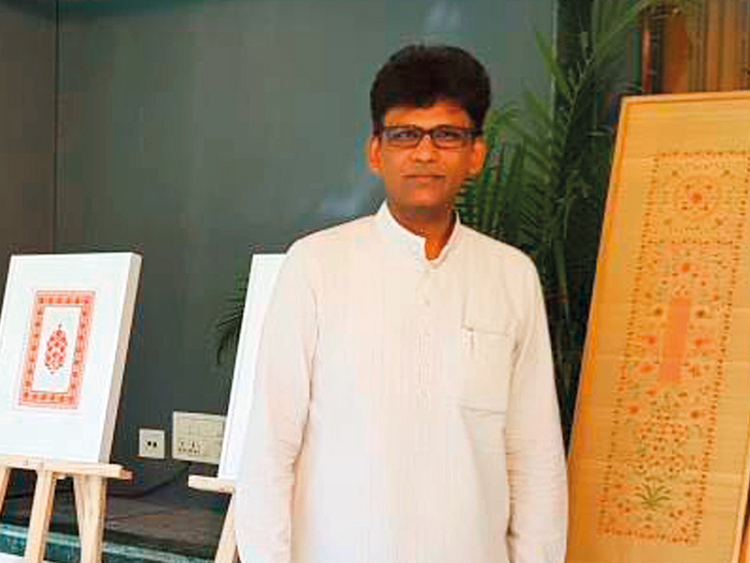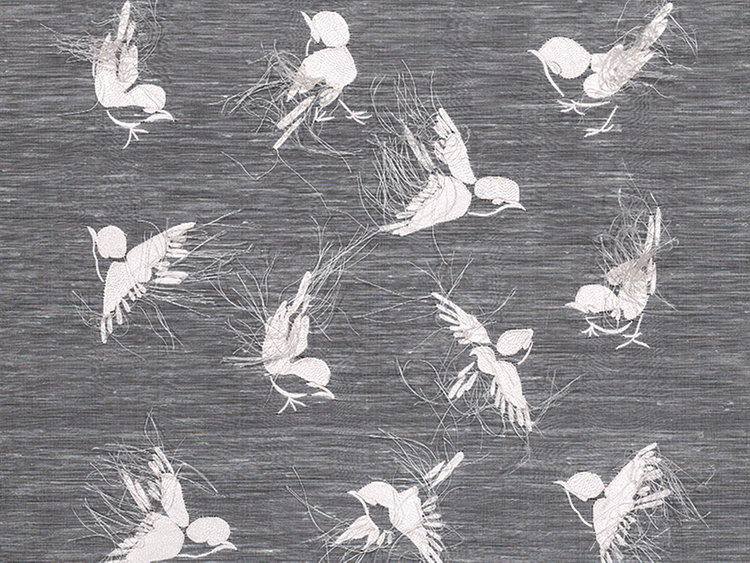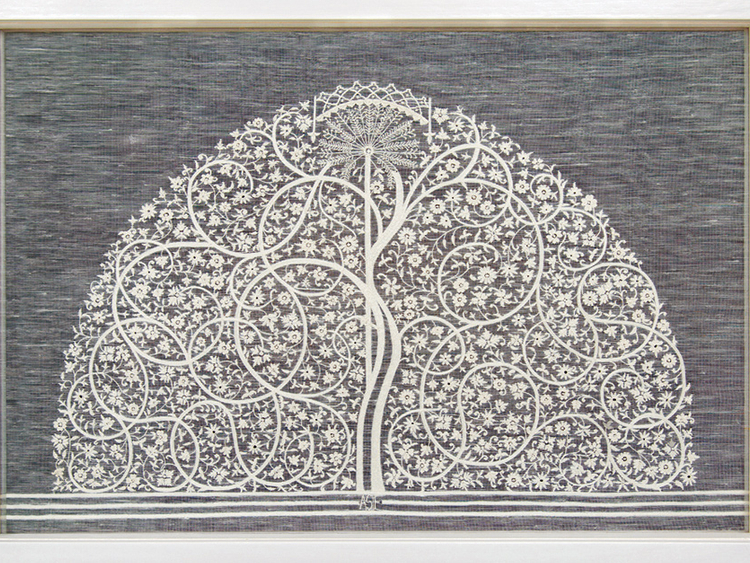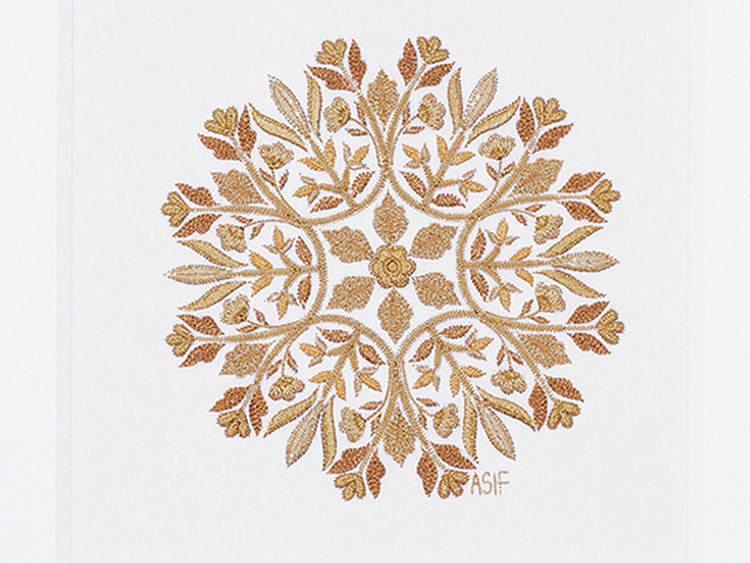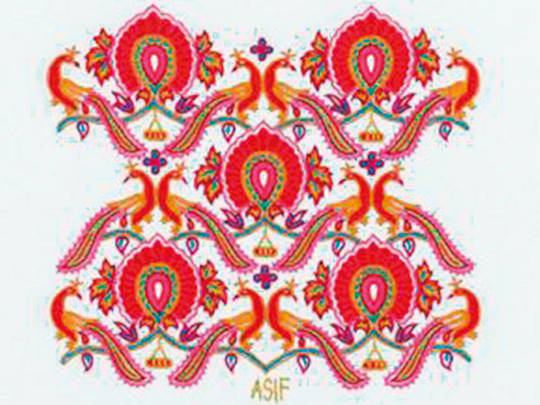
A new art collection using hand embroidery in its finest form is on display at the William Siegal Gallery in Santa Fe in the United States. It is the first time that an Indian embroidery art show is being presented in America.
The collection, Aakansha (Aspiration) is an expression of Ahmedabad, Gujarat-born Asif Shaikh’s aspiration to celebrate his 25 years as a master craftsman. He has wielded his needle and thread upon the best of fabrics created by fellow masters of their craft. Conveying his happiness, Shaikh says, “Last year, during my visit to Santa Fe, I went to see the gallery. Amazed by the works displayed there, I approached them to find out if my craft could be exhibited at their gallery and in some time I got an approval. I am deeply honoured to have the opportunity to celebrate my skills and present works of art created in embroidery, a technique and art form that is seldom exhibited on its own.”
The William Siegal Gallery is a high-concept space that exhibits a distinguished collection of ancient art and artifacts alongside contemporary works of art. The 5,000 square-foot gallery provides a rare opportunity to appreciate art that spans 5,000 years and many different cultures. For over 40 years, William Siegal has assembled the world’s largest collection of fine ancient Andean textiles dating from 750BC to the 19th Century. The gallery also exhibits ceremonial objects and artifacts from Meso and South American cultures, as well as objects from ancient Chinese, Southeast Asia, African and Indonesian civilisations. Along with inspiring a new collecting sensibility and the proximity between the old and the new, it conveys a sublime and timeless trans-cultural aesthetic of modernism.
It took Shaikh around three months to put together the entire collection that comprises 46 frames and two installations. Representing Ahmedabad, he has created embroidery of the Sidi Saiyyed Jali as a reflection on the city, displaying along side the beauty of Indian textile art in numerous other pieces that are inspired by Mughal miniature paintings. Known for his detail and quality, all embroideries presented by him are framed with museum-quality mounts and acid-free materials.
Some of the embroideries are so fine that one may need a magnifying glass to experience the delicateness of the needlework. The materials used are natural, hand-woven fabrics from various parts of India. These are embellished with the finest yarns available. Some works are further enriched with the use of gold-plated silver thread, rubies and even beetle wings.
“The motifs in this collection are old, but they have a style that makes them as contemporary today as they were when first used in paintings or on textiles. A majority of them originate from Mughal works dating back to the 16th and 17th centuries. The Mughal era was an artistic golden age for the Indian subcontinent. The best aspects of diverse traditions brought together to become a style all its own, reflected in the art, textiles and architecture. The Persian influence upon Mughal art was significant and the viewers may observe Persian themes in this collection,” Shaikh says.
He has used aari embroidery (chain stitch), zardozi and marodi work on karchob and the colours include white, off-white, cream and beige. He has experimented with Benarasi brocade, Tanchoi, Chanderi, Maheshwari and net from Varanasi in Uttar Pradesh. “I worked with a craftsman in Varanasi to create the fine gold thread, testing the thickness using a magnifying glass, till I got the quality I wanted,” he explains.
Shaikh has also carried out the Mughal tradition of using real gemstones on textiles by applying beetle wings from Thailand on a garment. He has recreated what the Nizams of Hyderabad used in their bandobast embroidery. His other experiments include a hand-woven Pashmina embroidered with Pashmina yarn — something that has never been attempted for marodi embroidery.
Known for his eye for detail, colour, aesthetic sensibility and quality, Shaikh is acknowledged as the man whose embroidery makes birds and flowers come alive. His works have been the basis for his recognition as a master of his craft both in India and abroad. Resurgence, the line of textiles he designed and released few years ago have been shown around the world. It played an integral part in reviving India’s rich embroidery legacy and at the same time looked towards new innovations to help it thrive.
A master embroiderer, revivalist and craft exponent, Shaikh’s passion for embroidery and fine textiles became evident when he was just seven-years’ old. Born into a middle-class family in one of India’s great textile hubs, Ahmedabad, he recalls:, “I was fascinated witnessing my mother transform a plain piece of cloth to an object of beauty.” He cultivated his interest by modifying garments, enriching them with motifs from older traditions. As his research into the exquisite motifs of previous eras deepened, he refined the motifs to suit modern concepts.
He joined Ahmedabad’s Centre for Environmental Planning and Technology University and attended the School of Interior Design and trained himself as an interior designer. “I wanted to further develop my aesthetic sensitivity and expand my knowledge of traditional and contemporary techniques,” he says. Shaikh went on to top the class. Undeterred by remarks that embroidery and designing was a woman’s job, he learnt the rare and difficult stitches and proved his critics wrong. “My thirst for getting to the bottom of how things are produced, ensured a thorough knowledge of weaving techniques, printing and dyeing, natural colours, embellishing techniques, threads and all the apparatus that goes into making and presenting a finished product,” he explains.
Imploring craftsperson not to forsake being exquisite, he says, “India may lose its 2,000-years-old heritage of variety and richness in needlework, weaving and dyeing if we do not wake up even now. But for that, it is imperative to respect and give credit to the artisans whose works are used by the designers. The artisans and their families continue to live in deplorable conditions in remote villages, with little or no amenities. And that is why machine embroidery, done with cheap threads, rules the market.”
Shaikh says his goal is not just to preserve but also to advance the art of embroidery and propel it to another level of craftsmanship and beauty. In the past two decades, he has revamped tools and techniques along with developing new stitches. “All this is evident in my show at Santa Fe,” he says excitedly.
Recognition on the world platform has been exhilarating and kept Shaikh going. However, the 48-year-old craftsman feels “there is a lot to be done at home in India.” While his journey continues, the Department of Industrial Policy and Promotion recently nominated him to the Indian Design Council. With a mission to promote artisans in India and abroad, and to make people understand and appreciate the beauty and elegance of hand embroidery Shaikh has set up Craft+Design+Society (CDS) Art Foundation in his hometown. CDS organises fashion shows where designers and artisans walk the ramp together to showcase their work. In addition he manages classes and workshops for artists. “The mission is to create brands out of artisans and crafts persons, backed by designers,” he explains.
Shaikh established his label Asif in 2002 and produces women’s wear, men’s wear and accessories. He also has his own range of decorative textiles and as it was done for royal patrons in earlier times, each product is meticulously designed and crafted for his clients. His works have been so appreciated that the Victoria and Albert Museum in London chose Shaikh to revive the 18th century aari embroidery for the museum. The Unesco-Parzor Foundation chose him to carry out the project of reviving the Chinese embroidery techniques and designs, referred to as parsi gara that was patronised by the Parsi community of India. Inspired by his love of Japanese textiles and motifs, he designed intriguing hand woven, indigo-dyed cotton and silk textiles, embroidered with koi, cherry blossoms and leaves. “By way of my craft, I intend to touch the lives of generations around the world, whom I have not met,” he says..
Among the various awards won by Shaikh are the Unesco Seal of Excellence for gara embroidered stole and (2012); Unesco Seal of Excellence for kamdani embroidered scarf (2012); Award of Excellence for Handicraft, aari embroidered scarf from the World Craft Council (2014); bronze for flying birds on scarf at the Nantong International Contemporary Craft Biennale, held in Nantong, China (2014); and bronze for ajrakh shawl in Nantong, China (2014).
Nilima Pathak is a journalist based in New Delhi.



